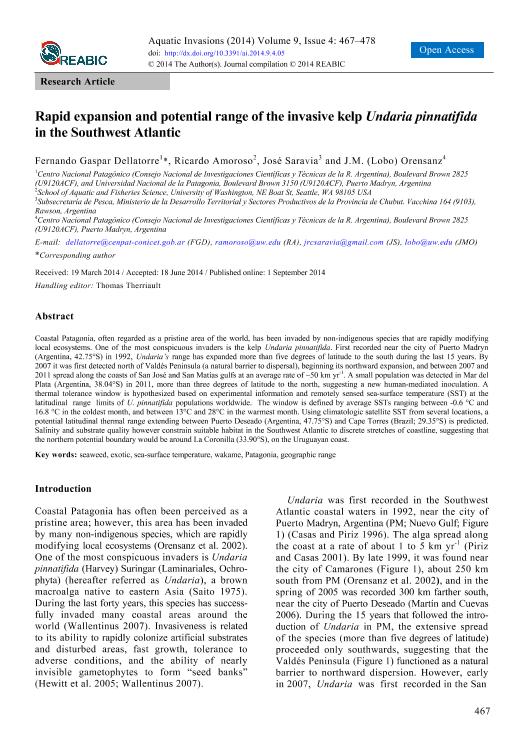Artículo
Rapid expansion and potential range of the invasive kelp Undaria pinnatifida in the southwestern Atlantic
Fecha de publicación:
09/2014
Editorial:
Regional Euro-Asian Biological Invasions Centre (REABIC)
Revista:
Aquatic invasions
ISSN:
1798-6540
Idioma:
Inglés
Tipo de recurso:
Artículo publicado
Clasificación temática:
Resumen
Coastal Patagonia, often regarded as a pristine confine of the world ocean, has been invaded by non-indigenous species that are rapidly modifying local ecosystems. One of the most conspicuous invaders is the kelp Undaria pinnatifida. First recorded near the city of Puerto Madryn (Argentina, 42.75°S) in 1992, during the last 15 years its range spread more than five degrees of latitude to the south. By 2007 it was first detected north of Valdes Península (a natural barrier), beginning its northward expansion, and between 2007 and 2011 spread along the coasts of San José and San Matías gulfs at an average rate of ~50 km yr-1. A small population was detected in Mar del Plata (Argentina, 38.04°S) in 2011, more than three degrees of latitude to the north, suggesting a new human-mediated inoculation. Based on experimental information and remotely sensed sea-surface temperature (SST) at the latitudinal range limits of U. pinnatifida populations worldwide, we hypothesize a thermal tolerance window between -0.6 °C and 16.8 °C average SST in the coldest month, and between 20 °C and 28 °C in the warmest month. Using climatologic satellite SST from several locations, we predict a potential latitudinal thermal range extending between Puerto Deseado (Argentina, 47.75°S) and Torres (Brazil; 29.35°S). Salinity and substrate quality however constrain suitable habitat in the southwestern Atlantic to discrete stretches of coastline, suggesting that the northern potential boundary would be around La Coronilla (33.90°S), on the Uruguayan littoral.
Palabras clave:
Seaweed
,
Exotic
,
Undaria
,
Wakame
,
Patagonia
,
Geographic Range
Archivos asociados
Licencia
Identificadores
Colecciones
Articulos(CCT-CENPAT)
Articulos de CTRO.CIENTIFICO TECNOL.CONICET - CENPAT
Articulos de CTRO.CIENTIFICO TECNOL.CONICET - CENPAT
Citación
Dellatorre, Fernando Gaspar; Amoroso, Ricardo Oscar; Saravia, José; Orensanz, Jose Maria; Rapid expansion and potential range of the invasive kelp Undaria pinnatifida in the southwestern Atlantic; Regional Euro-Asian Biological Invasions Centre (REABIC); Aquatic invasions; 9; 4; 9-2014; 467-478
Compartir
Altmétricas




